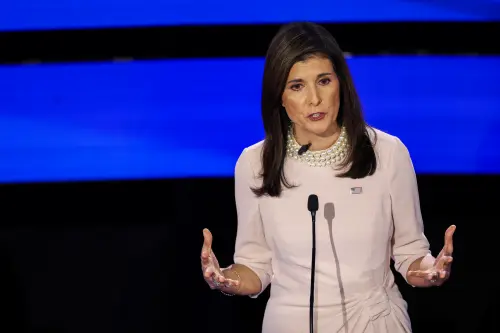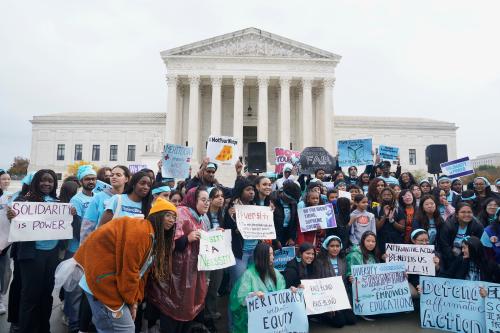One year ago, Brookings experts wrote a series of
12 memos to the incoming president
on the most pressing policy issues facing the country. Now they assess the administration’s progress on those issues in
The Status Report
, a daily series of commentary with video to be featured in POLITICO’s
Arena
.
Steven Pifer and Strobe Talbott give President Obama an A- in tackling the transnational threats posed by nuclear proliferation, the arms race with Russia, and climate change. They are taking into account the difficulties that Obama faces in four respects: the sheer magnitude and complexity of the agenda, a sometimes difficult Russian negotiating partner, the burden of the Bush legacy of unilateralism, and the intensity of political opposition.
Leadership in Facing Transnational Threats: A-
Shortly after his inauguration, President Obama reasserted U.S. leadership in the effort to contain and reduce the nuclear threat. He announced his goal of a world free of nuclear weapons, while making clear that a lot had to happen before achieving that long-term objective, and embraced arms control as a means to enhance U.S. national security. As our former colleague Carlos Pascual advised in a memo to the president-elect last January, quick, strategic action is imperative.
Meeting in April in London, presidents Obama and Medvedev launched the first serious U.S.-Russian arms reduction negotiations in more than a decade and laid down a very ambitious objective: complete by December a new agreement to replace the expiring Strategic Arms Reduction Treaty (START). Seven months of negotiations failed to meet that deadline. While disappointing, it was not particularly surprising. Remember that it took six years to negotiate START.
By year’s end, Washington and Moscow had significantly narrowed their differences over the numerical limits for the new treaty and focused their attention on verification issues. By all accounts, they are getting close. Look for a new treaty in the first few months of 2010. The Obama administration hopes then to build on that treaty to pursue even more ambitious nuclear arms cuts, including expanding the negotiations to reduce and limit tactical nuclear weapons.
Obama will host 40 leaders at an April 2010 summit on securing nuclear materials. This won’t be an especially sexy affair, but it could produce important practical arrangements to secure highly-enriched uranium and plutonium. Anything that makes it harder for terrorists and rogue states to acquire the materials for a nuclear bomb is a plus.
The administration’s pursuit of nuclear arms reductions has burnished Washington’s non-proliferation credentials, which will be important when the Non-Proliferation Treaty review conference is held in May. U.S. officials will be in a much stronger position to press the conference to strengthen the non-proliferation regime and place greater obstacles in the path of nuclear wannabes.
The president also hopes to push for U.S. ratification of the Comprehensive Test Ban Treaty (CTBT), which the Senate rejected eleven years ago. The administration should have good arguments to make the case why CTBT ratification makes sense now. It does not want a second rejection, so it will have to get the substance and timing with the Senate right.
The Obama administration cannot claim much progress in reversing North Korea’s nuclear weapons program or stopping Iran’s. The North Koreans conducted their second nuclear test, while Iran pressed ahead with its nuclear enrichment effort. Still, Obama’s policy of engagement has positioned the United States so that the failure rests entirely with the leaderships of those two countries. That strengthens Washington’s hand for a press for significant sanctions. For example, in the case of Iran, the administration’s diplomacy has built a unified approach with Europe and elicited the strongest Russian statements to date on the need for tough measures should Iran not cooperate. This won’t be a magic bullet, but the sanctions battle should be one between the world and the offending states, not a fight among Washington, Europe and Russia.
On climate change, the President has pushed Congress to pass cap-and-trade legislation that would, for the first time, put a price on carbon emissions. He also took the bold step of going to Copenhagen for a crucial and partially successful effort to rescue the summit from a total breakdown.
On both sets of issue—nuclear security and climate—Obama had to make up for time lost under his predecessor George W. Bush, who had little use for arms control and non-proliferation treaties and who didn’t recognize the severity of global warming until near the end of his term. International discontent with Bush translated into high—and in some ways unrealistic—expectations about what Obama could do, and how quickly.
Adding to the obstacles he faces is ferocious domestic partisanship that definitely doesn’t stop at the water’s edge. That problem is exacerbated by the approach of the mid-term congressional elections and, on climate change, the significant number of Democrats from coal-dependent states who may side with Republicans in opposing cap-and-trade.
If Obama can make progress on the home front commensurate with what he has shown himself able to do in diplomacy abroad, he would earn a solid A in his second year.
Javascript is not currently enabled in your browser.
Please enable Javascript in order to view this video.



Commentary
The Status Report: Obama’s Leadership Abroad
January 19, 2010